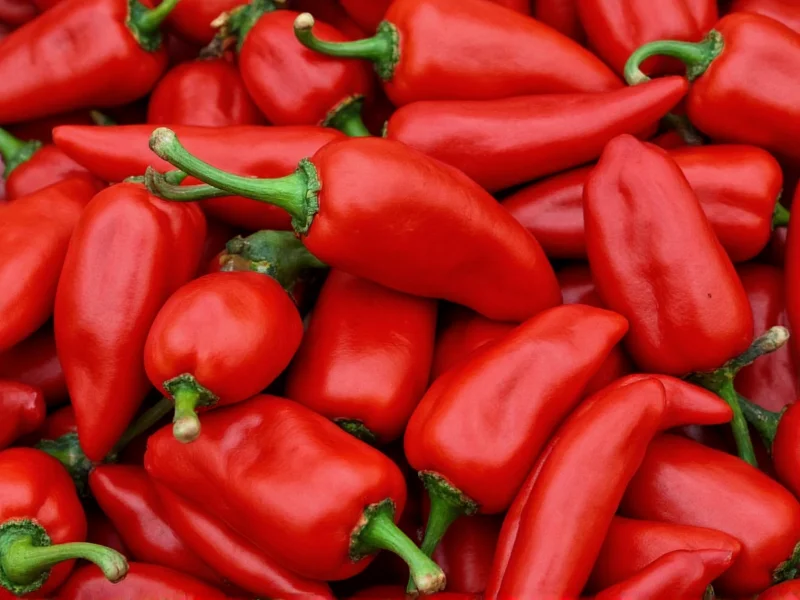Understanding exactly how hot are cayenne peppers requires context within the broader chili pepper family. The Scoville scale, developed by pharmacist Wilbur Scoville in 1912, remains the standard measurement for chili pepper heat. This scale quantifies the concentration of capsaicinoids—the compounds responsible for that burning sensation—in Scoville Heat Units.
Where Cayenne Peppers Rank on the Heat Scale
When evaluating how hot are cayenne peppers compared to other varieties, it's essential to recognize their position in the pepper hierarchy. Cayenne's 30,000-50,000 SHU range puts it approximately 12 times hotter than a standard jalapeño (2,500-8,000 SHU) but substantially milder than extreme peppers like the ghost pepper (855,000-1,041,427 SHU).
| Pepper Variety | Scoville Heat Units (SHU) | Heat Comparison to Cayenne |
|---|---|---|
| Bell Pepper | 0 SHU | 0 times (no heat) |
| Jalapeño | 2,500-8,000 SHU | 4-16 times milder |
| Cayenne | 30,000-50,000 SHU | Baseline |
| Thai Bird's Eye | 50,000-100,000 SHU | 1-2 times hotter |
| Habanero | 100,000-350,000 SHU | 2-10 times hotter |
| Ghost Pepper | 855,000-1,041,427 SHU | 17-35 times hotter |
Factors That Influence Cayenne Pepper Heat
The exact heat level of cayenne peppers varies significantly based on several factors. When considering cayenne pepper Scoville units range, remember that growing conditions dramatically impact capsaicin production:
- Climate and soil conditions - Hotter, drier environments typically produce more capsaicin
- Maturity level - Fully ripe red cayennes are generally hotter than green ones
- Genetic variation - Different cayenne cultivars have distinct heat profiles
- Plant stress - Mild environmental stress can increase capsaicin production
- Part of the pepper - The placenta (white ribs) contains the highest concentration of capsaicin
Practical Implications of Cayenne's Heat Level
Understanding how hot are cayenne peppers helps home cooks and professional chefs use them effectively. The medium-hot classification means cayenne delivers noticeable heat without overwhelming other flavors—a quality that explains its popularity in global cuisines.
When substituting cayenne in recipes, consider these practical guidelines:
- Use 1/8 to 1/4 teaspoon of cayenne powder to replace one fresh cayenne pepper
- Start with smaller amounts and gradually increase to avoid overpowering dishes
- Remember that dried cayenne often concentrates the heat compared to fresh
- Balance cayenne's heat with dairy, sugar, or acid components in recipes
Safety Considerations When Handling Cayenne Peppers
Given why are cayenne peppers so hot, proper handling techniques prevent uncomfortable situations. Capsaicin doesn't dissolve in water but does dissolve in fats and oils, which explains why dairy products help alleviate the burn.
Follow these safety tips:
- Wear gloves when handling fresh cayenne peppers
- Avoid touching your face, especially eyes, while working with peppers
- Wash hands thoroughly with soap after handling, even when wearing gloves
- Use separate cutting boards for hot peppers to prevent cross-contamination
- Have dairy products like milk or yogurt nearby when tasting spicy dishes
Common Culinary Uses of Cayenne Peppers
The specific cayenne pepper heat level chart position makes it versatile across numerous cuisines. Unlike extremely hot peppers that primarily add heat, cayenne contributes both warmth and distinctive flavor.
Popular applications include:
- Creole and Cajun seasoning blends (typically 10-25% cayenne)
- Hot sauces where balanced heat is desired
- Meat rubs for chicken, pork, and beef
- Enhancing flavor in soups, stews, and chili without overwhelming heat
- Baking applications like spicy chocolate desserts
- Preservation techniques where heat helps prevent spoilage
Measuring Pepper Heat Accurately
Modern science has refined cayenne pepper heat measurement beyond the original Scoville Organoleptic Test, which relied on human tasters. Today, high-performance liquid chromatography (HPLC) provides precise measurements of capsaicinoid concentration, then converts these to Scoville units through a standardized formula.
This scientific approach explains why reputable sources cite the 30,000-50,000 SHU range for cayenne peppers rather than a single number—the natural variation requires a range to accurately represent typical heat levels.
Frequently Asked Questions
How hot are cayenne peppers compared to jalapeños?
Cayenne peppers are significantly hotter than jalapeños, measuring 30,000-50,000 Scoville Heat Units compared to jalapeños' 2,500-8,000 SHU. This means cayenne is approximately 4-16 times hotter than a typical jalapeño, depending on the specific peppers being compared.
Is cayenne pepper hotter than habanero?
No, cayenne pepper is not hotter than habanero. Habaneros measure 100,000-350,000 Scoville Heat Units, making them 2-10 times hotter than cayenne peppers (30,000-50,000 SHU). Habaneros deliver a more intense, floral heat compared to cayenne's straightforward burn.
Can you eat cayenne peppers raw?
Yes, you can eat cayenne peppers raw, but exercise caution. Their significant heat level (30,000-50,000 SHU) can cause intense burning sensations. If trying raw cayenne, start with a very small piece, have dairy products available to mitigate the heat, and avoid touching your face afterward. Many people prefer using cayenne in cooked dishes where the heat distributes more evenly.
How much cayenne pepper equals one fresh cayenne?
Approximately 1/8 to 1/4 teaspoon of cayenne powder equals one fresh cayenne pepper, depending on the recipe and desired heat level. Drying concentrates the capsaicin, making the powder significantly hotter by volume than fresh peppers. Always start with less than you think you need and adjust gradually.
Why do cayenne peppers vary in heat?
Cayenne peppers vary in heat due to multiple factors including growing conditions (soil, climate, water), maturity level at harvest, genetic variations between cultivars, and even the specific part of the pepper. Stressors like drought can increase capsaicin production, making some cayennes hotter than others of the same variety.











 浙公网安备
33010002000092号
浙公网安备
33010002000092号 浙B2-20120091-4
浙B2-20120091-4